

- Call 908 543 4390
- Email
- Dr.Joni Redlich PT,DPT


If you know what Physical Therapists do, you know one of the big things we focus on are MUSCLES! I’m sure you have heard all about your glutes and your abdominal muscles, but there is one group of muscles you may not have heard that much about, because it gets a little neglected sometimes. These muscles are the ones that help you BREATHE! Yes, there is a whole group of muscles that help you breathe, and just like every other muscle in the body, they can be EXERCISED to improve strength, endurance, and control. Normally, you don’t have to think when you breathe, which is really awesome because if we did have to think, we would probably not have the brain power to do anything else. But when we do think about breathing, we can teach the muscles to work in new and more efficient ways. Once you do train these muscles to work better, they start working like that for automatic breathing too! We miss doing these types of exercises at the clinic because of COVID, but that doesn’t mean they can’t be done in a safe, COVID free home environment!
Now, you might be asking yourself, why does this matter? Well, if you notice your child becoming out of breath while trying to walk and talk at the same time, they might have difficulty keeping their breathing efficient while they are moving around. If your child frequently becomes quiet or holds their breath when trying difficult things, they may have trouble coordinating breathing with complex motor and cognitive tasks. If this sounds like your child, here are some exercises that may be helpful for training their muscles for breathing for greater efficiency:
If you found this information interesting and believe these concepts may apply to your child, but would like a second opinion, come on over to KidPT for a consultation with one of our Physical Therapists! And remember, inhale, exhale, and you will go places!
Disclaimer: All information in this post is for educational purposes only. If looking for medical advice, seek a doctor or related healthcare provider.

We’re all back in the swing on school after a nice holiday break off! With the transition back to school comes a shift in priorities, back to classes and schoolwork, and we know all you want to do is set your child up for success in the new year! Many kids have trouble keeping their posture upright throughout the day, and good, supported posture is one of the key elements leading to good focus while in school. Though you might not be able to do much about this while they are in person, you can adapt their environment to support them while they are remote learning. Here are some things to look for and tips to get you started:
Remember, it is hard for anyone to focus when they are having trouble staying on balance or trouble activating their muscles for the long virtual school day. But, with these tips you can have your child on the path to postural support while learning in no time! You got this parents!
If you liked these tips or want to watch the video for this post, click here:

Stressed about the challenges the new year will pose for your child with learning new skills and reaching new goals? Don’t worry, you’ve come to the right place. Here at KidPT, we’re here to help your child to reach and exceed their potential. Just like we use every tool at our disposal to help our kiddos become successful here in the clinic, we believe parents should be empowered to do the same at home! To help you to help your child on their path toward success, we’ve written down some helpful hacks and philosophies that we use in our PT sessions every day that you can start to implement at home:
You’ve got this, and so does your child, and together you can be a confidence boosting TEAM!

Happy New Year! We all know what ringing in the new year means, new goals and shiny aspirations! We all hope that with the shift into a new year, we will be able to do things we haven’t done before, reach new heights, and achieve our dreams. With all of our heads in the clouds, we also have to remember that 2020 was a difficult year for everyone and that even though 2021 is a new year, we should cut ourselves some slack and give ourselves more time to work toward our goals along with time to destress. We don’t want to put too much pressure on ourselves, and we don’t want our kids to do this either. For them the new year means a new semester and new topics at school, and they can feel just as much stress from this shift as we adults can! Here are four ways that you and your child can destress and center yourselves with movement for a more successful and calm transition to the new year:

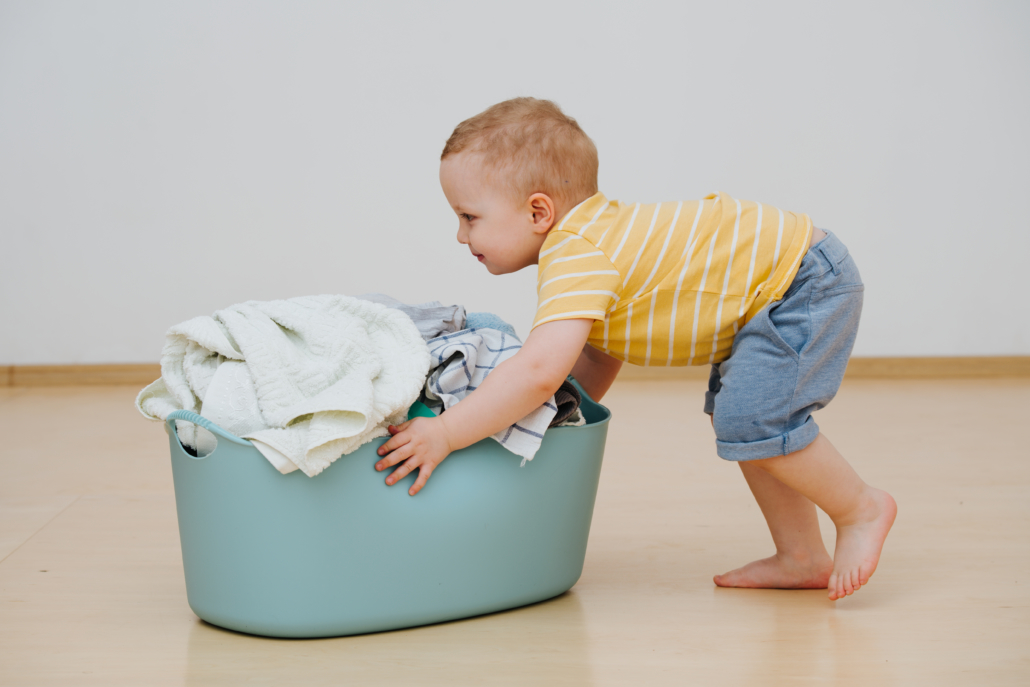
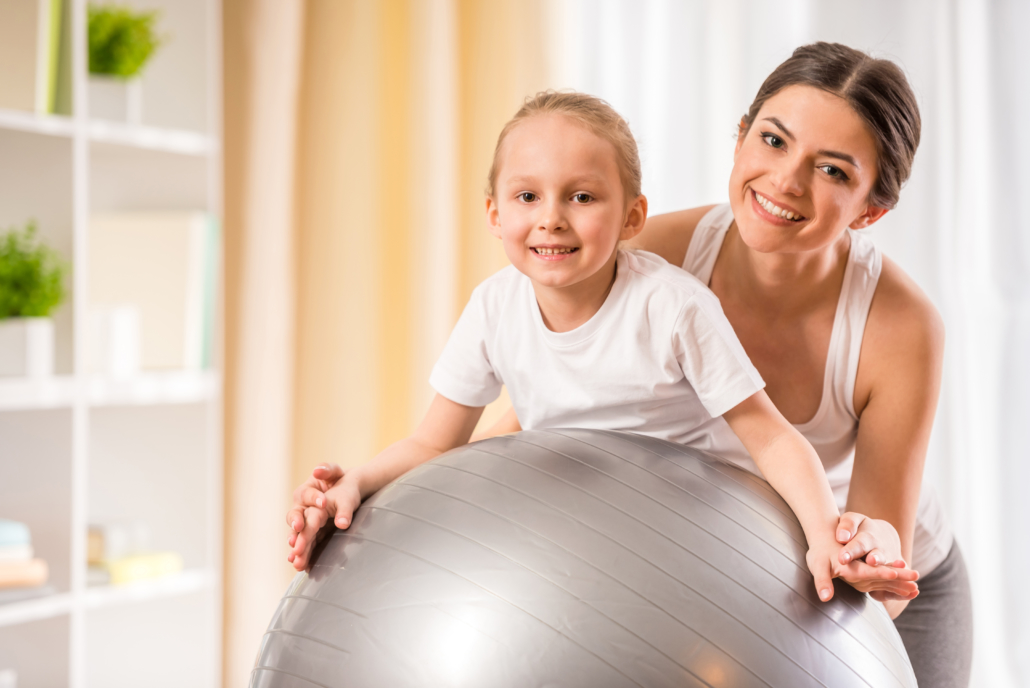
If you tried any of these strategies or if you would like more tips on how to stay calm and focused in the new year, email us at info@kidpt.com or message us on instagram @kidpt or facebook @kidptnj.
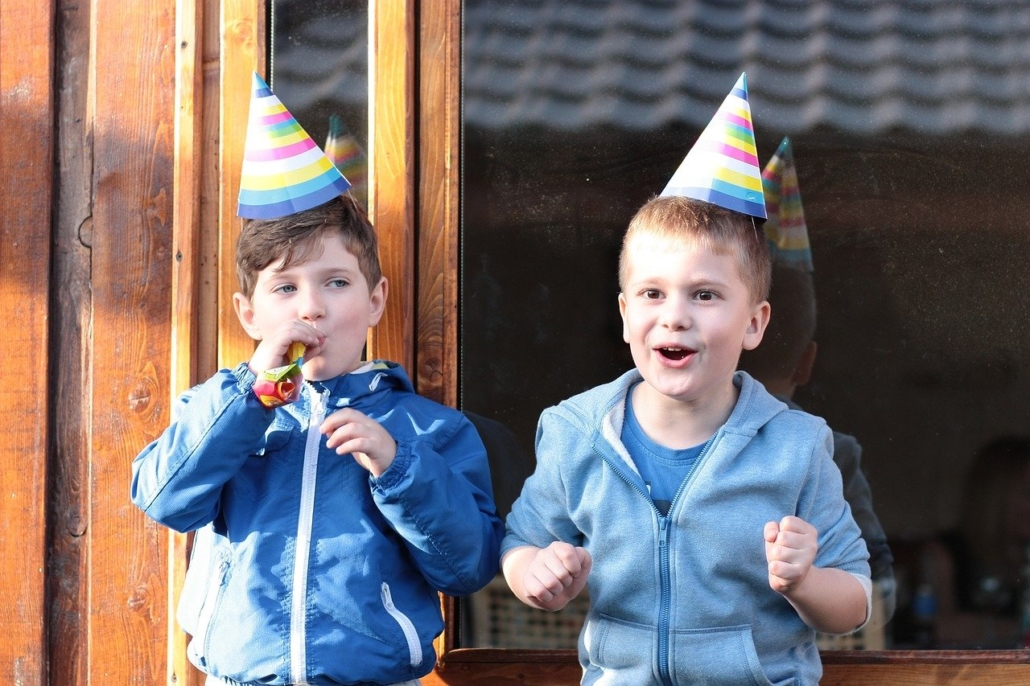
Are you ready for the ultimate New Year’s Countdown? Get ready to wiggle, jump, spin, and roll into the new year with these 10 awesome moves! For easier following along, click the link to the video at the bottom of this post
10. Ball Drop Jumps – To do these jumps, bring both knees into your chest while jumping into the air. Then land with both feet on the ground (compare to cannon ball jumps). Now you are looking like the sparkliest, shiniest new years ball ever!
9. (Virtually) Calling Friends and Family – Stand with your feet out wide, lean into one knee, and waive your hand or make a “telephone hand” and bring it up to your ear to call friends and family to wish them a Happy New Year! Repeat this 9 times total, leaning to opposite sides each time to calling 9 important people in your life!
8. Rising Apple Cider Bubbles – For this sweet move, crouch down until you are in a small ball close to the ground, with your hands touching the ground. Slowly wiggle your fingers and rise up until youre all the way on your tippy toes with your wiggly fingers in the air! Now you know what if feels like to be the bubbles in your Sparking Apple Cider! Repeat this one 8 times!
7. Confetti Squiggle Jumps – Jump in the air and wiggle your arms every which way to pretend you are kooky confetti, floating in all directions as it flies through the air
6. Clock Jumps – Point one toe forward to 12 o’clock on an imaginary clock on the floor. Then jump with your toe pointed to 1 o’clock, then 2 o’clock, 3 o’clock, and so on until you have jumped with one foot around the ENTIRE clock! Repeat with the other foot.
5. Logs on the fire – Start a warm fire by lying down on the ground on your back and roll to your tummy. Then roll to your back! To make it extra hard, try to not let your arms and legs touch the ground! Repeat this 5 more times (3 times to each side), to imagine yourself as your favorite new years treat!
4. Firework Jumping Jacks – Crack, pop, and sizzle as you do 4 jumping jacks and show off all your new years colors!
3. Globe Spins – Did you know that every time we celebrate a new year, the Earth has completed one full trip around the Sun? And every year, it takes 365 days for the Earth to complete this trip. Each day, the earth spins around one time! SO, as we spend the last days of 2020, thinking about 2021, the Earth is finishing its final spins for the year! Do 3 spins like the Earth does every day!
2. New Years Hugs – You’ve almost made it to 2021, give yourself two BIG hugs to show some appreciation to yourself for all the hard work you have done this year before the new year!
1. New Year Hooray Jumps – Do one star jump, where your legs and arms all jump outward at the same time. When you land, bring them back together. Don’t forget to shout “Hooray!”
Want to show us your New Year’s Countdown? Send us clips of you jumping your way through these moves! Email us at admin@kidpt.com or message us on Instagram or Facebook @kidPT and have a HAPPY NEW YEAR!!!

Many schools are going virtual until after the holidays, and we know what that means… more screen time. We’ve heard a pattern: many parents feel like it is hard for their child to stay engaged in their classroom activities when they are learning through a screen all day, and we hear ya, who wants to stare at a computer screen ALL DAY? Humans thrive through in person experiences, where they get to use every one of their senses, and this especially includes little humans!
Children are learning a high volume of information every day to make sense of their world and their ever changing environments. One great way to supply them with a lot of valuable information for learning and moving is to take them outside. Time outside will give them a break from the screen time and will give them the freedom and space to stretch their legs so they can move! Research says that kids can benefit from being outside for more than just a little fresh air, here are three of the amazing benefits of letting your kids immerse themselves in their outdoor world:
We hope your family gets to spend some quality outdoor time this fall! We’d love to see pictures of you playing and having a blast out there, so tag @kidpt on Facebook or Instagram or email admin@kidpt.com of you getting your fresh air on!! Stay tuned next week for outdoor distanced activities to keep your kids entertained and moving with their friends in a safe way.
References:
Faber Taylor, A., & Kuo, F. E. (2009). Children With Attention Deficits Concentrate Better After Walk in the Park. Journal of Attention Disorders, 12(5), 402–409. https://doi.org/10.1177/1087054708323000
Louise Chawla, Kelly Keena, Illène Pevec, Emily Stanley. Green schoolyards as havens from stress and resources for resilience in childhood and adolescence. Health & Place, 2014; 28: 1 DOI: 10.1016/j.healthplace.2014.03.001
We hope everyone had a very happy and safe thanksgiving, with lots of yummy food! One thing Thanksgiving always gets us thinking about is the holiday season and shopping for the best gifts that the kiddos in our lives will smile when opening!

Now, there are many kids these days who love screen time, video games, and everything electronic. Sometimes we hear parents saying “He loves the iPad” which is often followed with a statement about how worried they are that their child’s screen time is causing them to be less physically active and less interested in activities involving movement. First thing is first, if you’re reading this and nodding along, don’t worry, you are not alone! We are now in the technological age, and it is next to impossible to avoid screens. While it is important to limit screen time for a child who wants to use them 24/7, we can also use screens for movement!
Games involving screens are often very engaging, they involve a story line or a progression, many involve reaching goals and checkpoints, and usually very colorful. Studies show that when a child is engaged in an activity, their whole brain lights up, meaning their whole brain is being used and worked to complete a task and not just a small part of the brain. This means they are getting more out of the activity they are doing and making many connections in the brain!
So, if you want to engage your video game lover in an activity that will keep their attention but also will make them move, try a game that combines movement with a screen. Don’t get us wrong, screens ALL the time is not what we are advocating for here, but using something your child loves to make movement seem more valuable to them might save you a few headaches here and there.
Here is a list of games that your little gamer is sure to love:
Find out more here: https://ringfitadventure.nintendo.com/
Find out more here: https://bobo-balance.com/
Find out more here: https://www.ubisoft.com/en-us/game/just-dance/2021
Find out more here: https://www.nintendo.com/games/detail/arms-switch/
Find out more here: https://www.amazon.com/Disney-Fantasia-Music-Evolved-Xbox-One/dp/B00KVLPNL4
Find out more here: https://beatsaber.com/
Find out more here: https://www.pokemongo.com/en-us/
Find out more here: https://justdancenow.com/
Find out more here: https://zombiesrungame.com/
Find out more here: https://www.gonoodle.com/
Have fun moving together and if you find more movement games please share them with the Kid PT community!


by Dr. Ali
Happy November! When we think of November, we always think of good food and family fun! But with November usually comes a changing season and decreasing temperatures too! We understand how tricky it is to be a parent during these hard and strange times, and one concern we often hear, especially now, is “How do I keep my child moving now that the weather is getting colder and they can’t play outside?”
Have no fear! There are plenty of great activities your child can do to keep moving if you have to stay indoors, even if you don’t have a ton of space to work with! Below is one activity that you can set up for your child that is festive, can be done completely inside on a chilly day, and will keep them working toward achieving a final goal.
We’d love to see your turkeys AND your turkey dances! If you would like to share, tag us or message us @kidpt on Instagram or @kidptnj on Facebook. Gobble Gobble!
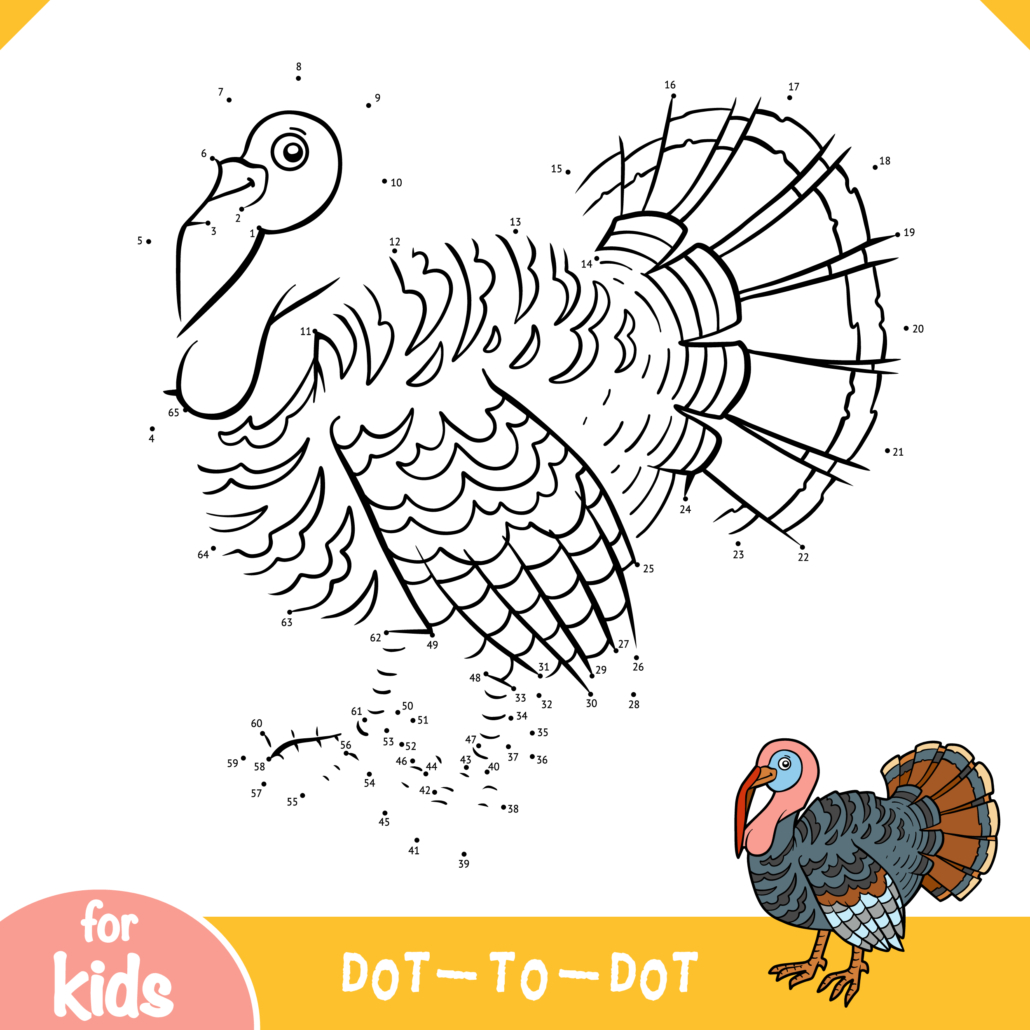
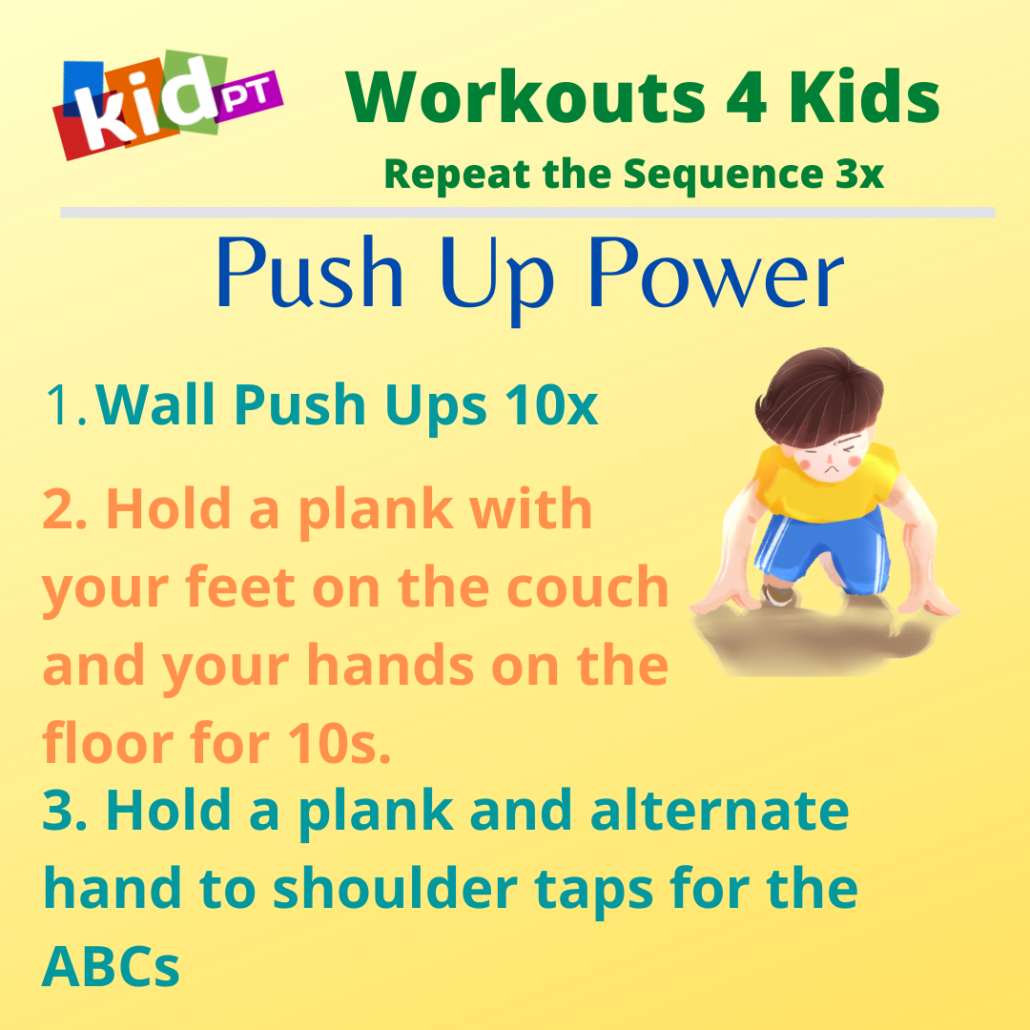
This week’s workout theme is a Push Up Power!
Try out these three moves and see if you can create a few more of your own!
Movement is always fun, but to build better control we need to keep our awareness on the quality of our movement.
Can we move slow and fast? Can we talk at the same time so we know we’re taking deep breaths? Can we keep good timing and sequencing as we go and not just at the beginning?
With our awareness ready, let’s go!
First, let’s try push ups in a way that we can control keeping our body’s in a strong straight line by doing wall push-ups.
Next, let’s try to hold a plank position. Not just any plank though- let’s put our feet on the couch and our hands on the floor and hold it here.
Last, let’s try some ABC shoulder taps!
Remember, if any of these positions are too hard to do with good QUALITY, move to a more upright position. Over time you can make it more challenging.
Come back next week to try out our next Wednesday workout! Have fun! Dr. Joni
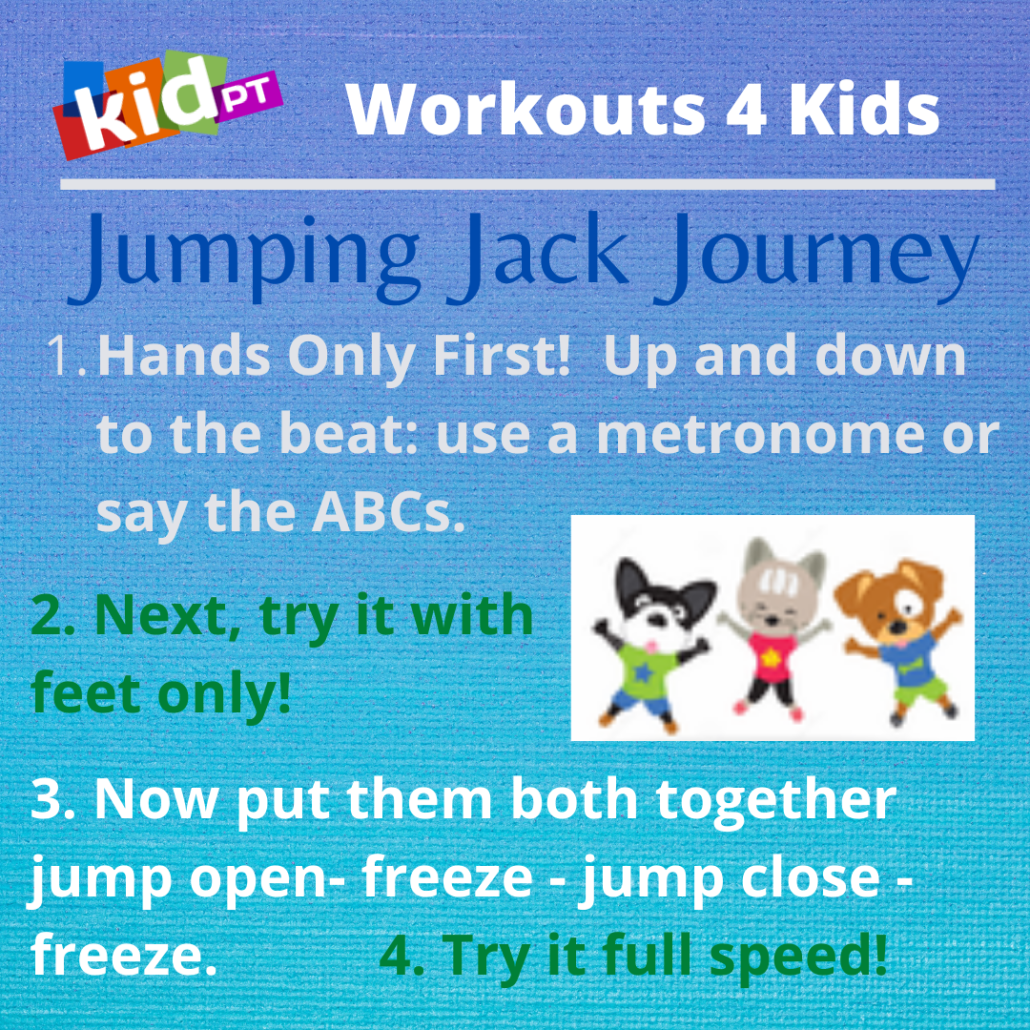
This week’s workout theme is a Jumping Jacks Journey!
Try out these three moves and see if you can create a few more of your own!
Movement is always fun, but to build better control we need to keep our awareness on the quality of our movement. Can we move slow and fast? Can we talk at the same time so we know we’re taking deep breaths? Can we keep good timing and sequencing as we go and not just at the beginning?
With our awareness ready, let’s go!
First, let’s move both arms up overhead and back down to our legs. Clap at the top and bottom to make an auditory cue.
Repeat to the letters of the alphabet, count to 10 or 20, or try to match the beat to a metronome (check out free metronome apps).
Next, let’s jump with legs open. Jump slowly. Jump open and freeze. Jump close and freeze. Make each jump a separate movement.
Now its time to put arms and legs together! Keep it slow still. Jump open and arms up- FREEZE! Jump close and arms down- FREEZE!
Once this is mastered, its time to speed it up!
Once Jumping Jacks are mastered, mix it up! Scissor jumps, X jumps, and side ski jumps are great varieties!
Come back next week to try out our next Wednesday workout!
Have fun!
Dr. Joni
